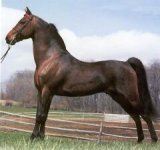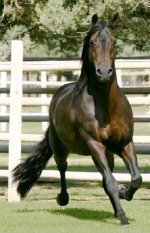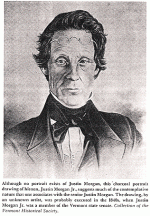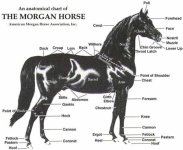اگر سوالی در مورد این نجاد دارید بهتره متن زیر رو بخونید
What is a Morgan?
A registered Morgan is the result of breeding two registered Morgan horses. All Morgans today trace to the stallion Justin Morgan, foaled in 1789, who was originally known by the name "Figure". The registry for Morgans was founded in 1909. Prior to that time, Morgans identified by Colonel Joseph Battell as descendants of Justin Morgan were considered Morgan horses.
The breed was formed from European horses brought in with colonists, and the Morgans set themselves apart with unique characteristics from their ancestors. Justin Morgan was, in fact, a genetic "sport" in that he did not resemble his sire or dam in obvious ways. He passed these characteristics on to his offspring, forming a distinct type or breed of horse unique to America. Justin Morgan sired many foals, but the most important ones are his three sons, Sherman, Bulrush, & Woodbury. Every Morgan today traces back to him through one of these stallions.
[
color=yellow]Is the Morgan America's first breed?[/color]
No, the Narragansett Pacer, a breed now extinct, preceded Morgans as a type of horse unique to America. The Morgan was the second "breed" unique and native to America. A "breed" is defined as: n. A group of organisms having common ancestors and certain distinguishable characteristics, especially a group within a species developed by artificial selection and maintained by controlled propagation.
To be an "American Breed" means the horses are something unique to this country, or bear unique characteristics and are not related to breeds with the same characteristics in another country. No other American breed can trace its pedigrees back as far as the Morgan horse can to the same foundation horse. The Morgan IS, indeed, the first true American breed based on bloodlines. Other breeds may have had that type of horse (pacer, harness racer, quarter racer) in colonial days but cannot claim those horses as ancestors today. Indeed, many were in fact offspring of Justin Morgan!
Who was Justin Morgan the man?
In her book on Justin Morgan, "Sing the Lord's Song in a Strange Land" Betty Bandel noted that the story of Morgan's life and the breeding of his famed stallion Figure, progenitor of all the Morgan horses, are of interest to lovers of horses and of music.
Morgan was a multi-faceted man who supported his family as a yeoman, musician, stallioneer, and tavern keeper in West Springfield, Massachusetts. Born in 1747, he descended from the first Springfield settlers (he was third generation). As a stallioneer he leased and stood the finest stallions obtainable – Diamond, the sire of Figure's dam, and True Briton (also known as Beautiful Bay), considered the sire of Figure.
In the post-Revolution year of 1788, Morgan and several of his brothers moved their families to the independent Republic of Vermont. He settled in Randolph becoming Town Clerk, Lister and Grand Juryman in addition to teaching choral singing and music composition, and farming. His anthems and hymns were first published in 1790 and 1791 - a great achievement at that time period. His wife died in 1791 following the birth of their fifth child, and Morgan succumbed to "consumption" in 1798.
Ironically, it was Figure, the "Justin Morgan Horse" that overshadowed the well-known and respected musician-farmer.
For more details on the life and times of Justin Morgan, the man, and Justin Morgan, the horse, please select the link to The National Museum of the Morgan Horse:
www.morganmuseum.org.
Who was Figure?
Figure was the founder of the Morgan breed, and later in life became known as "Justin Morgan's horse" and then "the Justin Morgan horse." Foaled in 1789, his exact parentage is unknown but is widely believed to have been by the thoroughbred stallion True Briton out of a mare said to be of Wildair breeding, who traced back to the Arabian and Barb roots of the thoroughbred breed. Standing just over 14 hands tall, Justin Morgan (Figure) was a powerful, very sound stallion who had the unique ability to pass his characteristics on to his offspring no matter what type of mare he was bred to. His genes were so dominant that they still determine the appearance of Morgans today. Despite a hard life spent working fields and pulling stagecoaches through the steep hills and mountains of Vermont, Justin Morgan lived to the age 32. He died following a kick he received in the pasture that was untreated and led to infection.
Morgan Families
There are four widely recognized families in the Morgan breed, which are briefly described below. A family is a group of horses from the same breeding program that have ancestors in common. The largest families are the Brunk, Government, Lippitt, and Western Working. There are also smaller "sub-families", which are horses descended from one horse or a particular breeding program.
Brunk Family
Morgans that trace to the breeding program of Joseph Brunk in Illinois are generally known for their soundness and athletic ability. Brunk's program revolved around breeding key mares, primarily of old Vermont breeding, to the best stallions available. Most Brunk Morgans have the mare Daisy numerous times in their pedigree. She was crossed with the stallions Ben Franklin, Senator, Jubilee De Jarnette, and Chetco, and the offspring crossed back to each other, creating a family linebred to Daisy.
Lippitt Family
Morgans tracing to several of the horses originating from the breeding program of Robert Lippitt Knight in Vermont are known today as "Lippitts". Morgans bred by Knight bear the prefix "Lippitt" at the beginning of their name and trace to the stallion Ethan Allen 2nd. Today two Morgan clubs cater to breeders who specialize in the Lippitt family lines. Their contact information can be found in the list of Related Links to Morgan clubs under "National Service Organizations."
Government Family
Morgans bred by the U.S. Government farm between 1905-1951 are called Government Morgans. The Government farm used the stallion General Gates as their foundation sire. It is the largest of the Morgan families. The U.S. Government dispersed the herd in 1950, with the University of Vermont purchasing many of the breeding stock to carry on the Government program.
Working Western Family (sometimes referred to as 2WF)
These horses do not have one breeder or ancestor in common but have a common purpose: to work the western ranges of the United States. Working Western Morgans drew from the Government stallions shipped out west to improve the quality of offspring from local mares, as well as Morgans from breeding programs in Kansas, California, Nevada and Texas. Breeders who specialize in working western lines can be found in the list of Morgan Clubs under the list of National Service Organizations at
http://www.morganhorse.com/resources/links_clubs.php.
Are Morgans Gaited?
Overall, the Morgan is not a gaited breed, although there are some gaited Morgans found within the breed. In the 1800s, Morgans were valued for their speed in harness, and both trotting and pacing Morgans came at a high price. Today, a few Morgans can be found that are capable of performing a rack, pace, fox-trot, or other lateral gaits in which the horse's movement is from side-to-side instead of up and down as found in diagonal gaits, such as the trot and canter. No specific families or bloodlines are predominant in producing Morgans that can gait today. Information on breeders producing gaited Morgans can be found in the list of National Service Organizations At
http://www.morganhorse.com/resources/links_clubs.php
How Long do Morgans Live?
Most horse will live for 20-30 years. Morgans are very long lived; many will live past 30 years if they are well cared for.
[
color=limegreen]Do Morgans Have Any Genetic Diseases?[/color]
Morgans have remarkably few medical conditions present in the breed. There are rare occurrences of equine conditions that are common to most or all other breeds of horses, such as Cushing's disease, a hormonal abnormality commonly encountered in many breeds of horses in advanced age. Fortunately, simple tests by your veterinarian can diagnose many such conditions, and the disorder can often be controlled with medication. Any conformational or health problems that can be passed on should be taken into consideration before choosing to breed your Morgan to insure the best possible offspring.
[
color=yellow]Are Morgans Easy Keepers?[/color]
Morgans are a long-lived, very healthy breed and suffer remarkably few problems with their legs and feet. They are well known for being easy keepers. They need a minimum of grain and grass compared with most other breeds, and they should be monitored to be sure they are not eating too much, especially sweetened feeds. Obesity can lead to health and soundness problems. Weight and condition of a Morgan is considered adequate to be when you can run your fingers along the horse's barrel and feel the ribs without having to push through a layer of fat, but cannot visibly see them. Horses that are well fed, but appear to be thin or gaunt, should be checked for worms, teeth problems, or other health problems by a veterinarian.
How do you feed and care for a Morgan?
Each Morgan is an individual and may have different requirements for care and nutrition depending on age, condition, and use. You will receive the best advice from your local veterinarian, who can evaluate your horse's needs based on his or her individual characteristics. The AMHA also offers the Youth and Adult Horsemastership programs that cover basic aspects of feeding and care for equines.
What size saddle will fit a Morgan?
Morgans can present challenges in finding saddles that fit properly. Poorly fit saddles can result in bad behavior just as shoes that don't fit you are uncomfortable! Both the width and length of the back should be inspected carefully for fitting. A broad, short back will not work well with a narrow, long saddle. Work with your local saddle shop or a catalog that provides saddle-fitting services to find the saddle most suited for your Morgan's conformation.
What color are Morgans?
Morgans come in many colors, and horses of all colors that meet other registration requirements are eligible to be registered. Descriptions of various coat colors, coat patterns and modifiers, and leg and face markings are provided on a downloadable form found at
http://www.morganhorse.com/benefits/forms.php.
What size are Morgans?
The height of a Morgan generally ranges from 14.1 to 15.2 hands, with some individuals under or over.
How many Morgans are there?
As of August 20, 2007, there were approximately 107,950 living registered Morgans.
[
color=yellow]What are Morgans used for?[/color]
Morgans excel in virtually all disciplines. They are one of the premier carriage horses in the world, and are used for combined driving, competitive trail, and endurance riding, eventing, working western events, dressage, all show ring disciplines, and as an excellent friend and companion whether in the backyard or on the trail.




